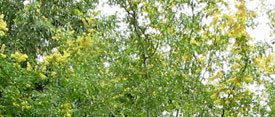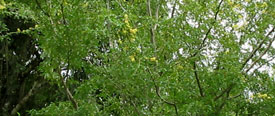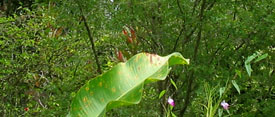|
|||||
At Dem Dats Doin we planted three logwood trees in 1994. They flowered and produced thousands of seeds after about 6 years. Although it is a leguminous tree the individual seed pods opens unlike other bean pods. The papery thin pod splits in the middle instead of at the edges. Haematoxylon means bloodwood, referring to the dark red heartwood. Campechianum refers to the coastal city of Campeche in Mexico. This thorny tree, 20-30 feet in height, is native to tropical America and the West Indies. Growing from thorny joints in the branches are clusters of small pinnate leaves. Bright yellow blossoms have five spreading petals turning to papery seed pods. The wood is very hard and dense. The debarked heartwood of Logwood was valued and exported for its use as a source of dye. By the mid 1800s cheaper dyes were discovered and Belize eventually shifted to the exportation of mahogany. The actual dye from logwood is hematoxylin. It is extracted by boiling the chips or soaking them in water using 'washing soda'. To make the dyes colorfast, they must be used with various mordants such as alum, acetic acid and cream of tartar. Put simply, the mordants serve to chemically bind the dye with the fabric/item. Different colors are produced depending on the type of mordant and duration of the dye bath. Colors range from bright reds, shades of blue, light lavender to deep blue-black. Logwood dyes have been used for cotton and woolen goods, leather, furs, silk and inks. Also stains for wood finishing. Dem Dats Doin after researching information for this article will in the very near future experiment with its logwood trees to produce a dye/stain to repaint its veranda wood floors. Meanwhile we export thousands of logwood seeds and recently sold the young logwood plants in our nursery to a collector of exotic tropical trees. |
|||||||||









